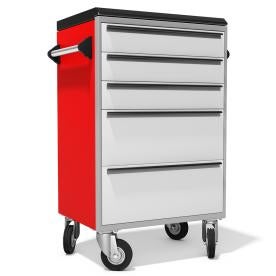Waterloo Industries Inc., on April 11, filed antidumping (AD) and countervailing duty (CVD) petitions on imports of certain tool chests and cabinets from China and Vietnam.
The U.S. AD law imposes special tariffs to counteract imports that are sold in the United States at less than “normal value.” For AD duties to be imposed, the U.S. government must determine not only that dumping is occurring, but also that there is “material injury” (or threat thereof) by reason of the dumped imports. Importers are liable for any potential AD duties imposed. In addition, these investigations could impact purchasers, by either increasing prices, and/or decreasing supply, of tool chests and cabinets.
Scope:
The scope of this petition covers certain metal tool chests and tool cabinets with drawers (“tool chests and cabinets”) from the People's Republic of China and the Socialist Republic of Vietnam. The scope covers all metal tool chests and cabinets, including top chests, intermediate chests, tool cabinets and side cabinets, storage units, mobile work benches, and work stations and that have the following physical characteristics:
-
body made of carbon, alloy, or stainless steel and/or other metals;
-
two or more drawers for storage in each individual unit;
-
a width (side to side) exceeding 21 inches but not exceeding 60 inches;
-
a drawer depth (front to back) exceeding 10 inches but not exceeding 24 inches; and
-
prepackaged for retail sale.
Prepackaged for retail sale means the units are packaged in a cardboard box or other container suitable for retail display and sale. Subject tool chests and cabinets are covered whether imported in assembled or unassembled form. Subject merchandise includes tool chests and cabinets produced in China or Vietnam but assembled, prepackaged for sale, or subject to other minor processing in a third country prior to importation into the United States. Similarly, it would include tool chests and cabinets produced in China or Vietnam that are later found to be assembled, prepackaged for sale, or subject to other minor processing after importation into the United States.
Subject tool chests and cabinets may also have doors and shelves in addition to drawers, may have handles (typically mounted on the sides), and may have a work surface on the top. Subject tool chests and cabinets may be uncoated (e.g., stainless steel), painted, powder coated, galvanízed, or otherwise coated for corrosion protection or aesthetic appearance.
Subject tool chests and cabinets may be shipped, packaged or sold as individual units or in sets. When sold in sets, they typically include a cabinet with one or more chests that stack on top of the cabinet. Tool cabinets act as a base tool storage unit and typically have rollers, casters, or wheels to permit them to be moved more easily when loaded with tools. Work stations are tool cabinets with a work surface on the top that may be made of rubber, plastic, metal, or wood.
Top chests are designed to be used with a tool cabinet to form a tool storage unit. The top chests may be mounted on top of the base tool cabinet or onto an intermediate chest. They are often sold as a set with tool cabinets or intermediate chests, but may also be sold separately. They may be sold with mounting hardware (e.g., bolts) and instructions for assembling them onto the base tool cabinet or onto an intermediate tool chest which rests on the base tool cabinet. Smaller top chests typically have handles on the sides, for purposes of lifting the chest out of the package onto the cabinet, while the larger top chests typically lack handles. Intermediate tool chests are designed to fit on top of the floor standing tool cabinet and to be used underneath the top tool chest. Although they may be imported, sold or used separately from the tool cabinet, intermediate chests are designed to be used in conjunction with tool cabinets. The intermediate chests typically do not contain handles. The intermediate and top chests have the capability of being bolted together. Side cabinets are designed to be bolted or otherwise attached to the side of the base storage cabinet to expand the storage capacity of the base tool cabinet.
Subject tool chests and cabinets also may be shipped, packaged or sold with a tool set included, and when this occurs the tools are part of the subject merchandise.
Excluded from the scope of the investigation are tool boxes, chests and cabinets with bodies made of plastic, carbon fiber, wood, or other non-metallic substances. Also excluded from the scope of the investigation are portable tool boxes. Portable tool boxes have each of the following characteristics: (1) fewer than three drawers; (2) a handle on the top that allows the tool box to be carried by hand; and (3) a width that is 21 inches or less; and depth (front to back) not exceeding 10 inches.
Also excluded from the scope of the investigation are industrial grade steel tool chests and cabinets. The excluded industrial grade steel tool chests and cabinets are those:
-
having a body that is over 60 inches wide; or
-
having each of the following physical characteristics:
(a) a body made of steel that is 0.055" or more in thickness;
(b) all drawers over 21" deep;
(c) all drawer slides rated for 200 lbs. or more; and
(d) not prepackaged for retail sale.
Also excluded from the scope of the investigation are work benches with fewer than two drawers. Excluded work benches have a solid top working surface, have fewer than two drawers, are supported by legs and have no solid front, side, or back panels enclosing the body of the unit.
Also excluded from the scope of the investigation are metal filing cabinets that are configured to hold hanging file folders and are properly entered into United States through Harmonized Tariff Schedule of the United States ("HTSUS") category 9403.10.0020.
Subject tool chests and cabinets enter the United States through HTSUS 9403.20.0030, but may also enter through HTSUS 9403.20.0026 and 1326.90.3500. While HTSUS subheadings are provided for convenience and Customs purposes, the written description of the scope of this investigation is dispositive.
Alleged Dumping Margins:
Petitioners allege a dumping margin of 167.50 percent for China, and a dumping margin of 58.20 percent for Vietnam.
Estimated Schedule of Investigations:
-
April 11, 2017 – Petition is filed
-
May 1, 2017 – DOC initiates AD investigation
-
May 2, 2017 – ITC staff conference (estimated)
-
May 26, 2017 – Deadline for ITC preliminary injury determination
-
July 5, 2017 – Deadline for DOC preliminary CD determination, if deadline is not postponed
-
September 8, 2017 – Deadline for DOC preliminary CVD determinations, if deadline is fully postponed
-
September 18, 2017 – Deadline for DOC preliminary AD determinations, if deadline is not postponed
-
November 7, 2012 – Deadline for DOC preliminary AD determinations, if deadline is fully postponed
-
March 12, 2018 – Deadline for DOC final AD/CVD determinations, if both preliminary and final AD determinations are fully postponed and the CVD deadline is aligned with the AD investigation
-
April 26, 2018 – Deadline for ITC final injury determination, assuming fully postponed DOC deadlines





 i
i

